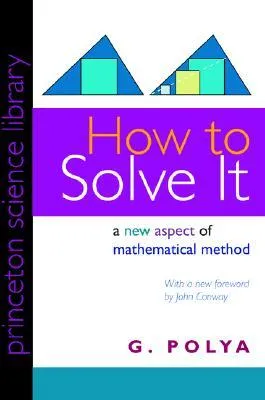How to solve it. A new aspect of mathematical method
4.6
Reviews from our users

You Can Ask your questions from this book's AI after Login
Each download or ask from book AI costs 2 points. To earn more free points, please visit the Points Guide Page and complete some valuable actions.Introduction to "How to Solve It: A New Aspect of Mathematical Method"
"How to Solve It: A New Aspect of Mathematical Method," authored by George Pólya, is a timeless masterpiece in the realm of problem-solving and mathematical thought. First published in 1945, this book has become a staple for mathematicians, educators, and problem-solvers across various disciplines. Its impact stretches far beyond mathematics, providing a lucid framework for systematic reasoning and a deeper understanding of problem-solving as a learnable skill. At its core, the book introduces a step-by-step process to approach and tackle problems, blending mathematical precision with universal logic applicable to everyday challenges.
Structured to illuminate the art and craft of problem-solving, the book focuses on the strategies and heuristics that guide successful problem solvers. Pólya's writing is clear, engaging, and infused with wisdom, making the content accessible to students, teachers, and professionals alike. Here, we'll delve into a detailed summary of the book, its key takeaways, some famous quotes, and an exploration of why this work remains profoundly relevant today.
Detailed Summary of the Book
The book is divided into two parts: the first part focuses on Pólya’s celebrated four-step approach to solving problems, while the second part delves into a deeper discussion of heuristic reasoning and its application.
Pólya's four-step problem-solving framework is as follows:
- Understand the problem: This step emphasizes reading the problem carefully, identifying the unknown, understanding the data, and determining the conditions. Without a clear comprehension of the problem, proceeding further will be futile.
- Devise a plan: Here, Pólya explores the various strategies one might employ to approach a solution. These include drawing diagrams, using similar problems, breaking the problem into smaller parts, and more.
- Carry out the plan: In this step, the problem solver implements the strategy devised in the previous stage. The emphasis is on precision, execution, and verifying that each step aligns with the overarching goal.
- Look back: Reflection is key to learning. After solving the problem, one must review the solution, find alternative methods, and extract lessons for future challenges.
The second part of the book expands upon the tools of heuristic reasoning — strategies that stimulate discovery and problem intuition. It includes techniques such as analogy, generalization, induction, and the use of auxiliary elements to simplify complex issues. Pólya also provides illustrative examples and incisive commentary to reinforce the principles of his methodology.
Key Takeaways
"How to Solve It" offers countless invaluable lessons for anyone interested in enhancing their problem-solving skills. Here are some key takeaways from the book:
- Problem-solving is a learnable skill that can be significantly improved with practice and the use of systematic methods.
- The four-step framework — understanding the problem, devising a plan, carrying out the plan, and looking back — serves as a foundation for approaching any problem effectively.
- Heuristics are not strict rules but tools to stimulate creative and logical thinking.
- Reflection and review are as important as solving the problem itself, as they consolidate learning and pave the way for growth.
- The process is often more valuable than the solution, fostering analytical and critical thinking skills applicable in all domains.
Famous Quotes from the Book
George Pólya’s writing is filled with insightful and motivational quotes that capture the essence of problem-solving and intellectual exploration. Here are a few memorable quotes from the book:
"A great discovery solves a great problem but there is always a problem behind a problem."
"Mathematics consists of proving the most obvious thing in the least obvious way."
"If you can’t solve a problem, then there is an easier problem you can solve: find it."
"Teaching to solve problems is education’s heart."
Why This Book Matters
"How to Solve It" is much more than a book about mathematics; it is a guide to systematic thinking and intellectual exploration. It matters because it lays bare the universality of problem-solving techniques, bridging the gap between academic theory and practical application. Whether you are a mathematician trying to prove a theorem, a software developer debugging code, or a student preparing for an exam, Pólya’s strategies provide a toolkit that is as effective as it is applicable.
Furthermore, the book underscores the importance of teaching thoughtfulness and creativity in education. Pólya advocates not just for instructing students about specific content, but for imparting the tools that help them think, discover, and innovate. It’s this timeless and universal perspective that keeps "How to Solve It" relevant even decades after its publication.
Ultimately, "How to Solve It" provides a clear roadmap to navigating uncertainty, fostering a mindset of perseverance, logic, and creativity. Its emphasis on cultivating independent thought and intellectual curiosity solidifies its place as one of the most influential books on mathematics and problem-solving ever written.
Whether you are new to problem-solving or an experienced practitioner, this book promises to transform the way you think about and approach challenges. Its principles will not only help you solve problems but also inspire deeper intellectual inquiry in all areas of life.
Free Direct Download
You Can Download this book after Login
Accessing books through legal platforms and public libraries not only supports the rights of authors and publishers but also contributes to the sustainability of reading culture. Before downloading, please take a moment to consider these options.
Find this book on other platforms:
WorldCat helps you find books in libraries worldwide.
See ratings, reviews, and discussions on Goodreads.
Find and buy rare or used books on AbeBooks.
1224
بازدید4.6
امتیاز50
نظر98%
رضایتReviews:
4.6
Based on 0 users review
"کیفیت چاپ عالی بود، خیلی راضیام"


